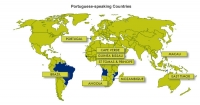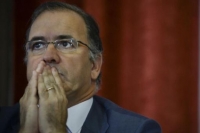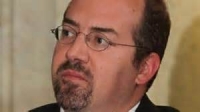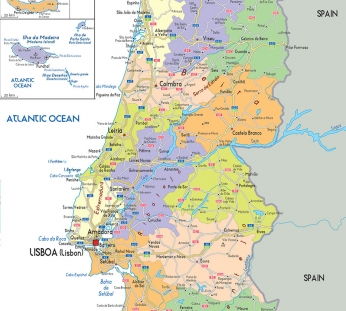
Portugal
Capital: Lisbon ; GDP growth (annual %) 2016 : 1.4%-
Portugal PPI Inflation Slows Further
Portugal's producer price inflation eased for the fourth consecutive month in July, figures from Statistics Portugal showed Friday.
Industrial producer prices climbed 2.2 % year-over-year in July, slower than the 2.8 % increase in June. The measure has been rising since December 2016.
More > -
Portugal's cork-to-oil mogul Amorim dies at 82
Americo Amorim, Portugal's richest man with business interests ranging from energy and finance to the world's major cork producer, Corticeira Amorim , died on Thursday aged 82, a company spokesman said.
He could not say what was the cause of death.
According to Forbes, Amorim's net worth was $4.8 billion and his biggest single investment an indirect 18 % stake in Portuguese oil company Galp Energia.
More > -
Portugal's cork-to-oil mogul Amorim dies at 82
Americo Amorim, Portugal's richest man with business interests ranging from energy and finance to the world's major cork producer, Corticeira Amorim , died on Thursday aged 82, a company spokesman said.
He could not say what was the cause of death.
According to Forbes, Amorim's net worth was $4.8 billion and his biggest single investment an indirect 18 % stake in Portuguese oil company Galp Energia.
More >
- Key Facts
-
Full name: Portuguese Republic
Population: 10.7 million (UN, 2011)
Area: 92,345 sq km (35,655 sq miles)
Major language: Portuguese
Major religion: Christianity
Life expectancy: 77 years (men), 83 years (women) (UN)
Monetary unit: 1 euro = 100 cents
Main exports: Textiles and clothing, wood products, electrical equipment
GNI per capita: US $21,880 (World Bank, 2010)
Internet domain: .pt
International dialling code: +351
-

Climate change laws around the world
2017/05/14There has been a 20-fold increase in the number of global climate change laws since 1997, according to the most comprehensive database of relevant policy and legislation.
The database, produced by the Grantham Research Institute on Climate Change and the Environment and the Sabin Center on Climate Change Law, includes more than 1,200 relevant policies across 164 countries, which account for 95% of global greenhouse gas emissions.
-

Brexit negotiations should treat energy as ‘special case’
2017/05/14There are strong practical reasons why the UK and EU should treat energy as a appropriate case during Brexit negotiations, argues a new statement.
The statement, jointly authored by Chatham Home, the University of Exeter and the UK Energy Research Centre (UKERC), says finding common ground on energy during the Brexit negotiations would benefit both the UK and remaining EU27, while compromise may be relatively easier to achieve than for other areas.
-

Portuguese banks weather the storm
2015/04/05Portugal’s banks may be battling an economic downturn and the next-effects of the Banco Espírito Santo collapse, but they are still preparing for a return to profitability.
Portuguese banking is in flux. The catastrophic collapse in 2014 of Banco Espírito Santo (BES), one the country’s oldest and best-known lenders, has shifted the tectonic plates of a sector by presently severely buffeted by the world financial crisis and a three-year international bailout.
-

China’s business in Portuguese-speaking countries continues to increase
2015/01/02The re-opening of the Benguela railway in 2014 will remain as China’s flagship project in Angola, but as well as a symbol of a year in which the relationship between China and Portuguese-speaking nations continued to increase.
Chinese ties with Angola, Mozambique and Cabo Verde (Cape Verde) involve Macau and Portugal, which in 2014 saw Chinese investment in the country rise to 10 billion euros, with several new deals expected in 2015, this time in the financial sector.
-

China proposes 3-year action plan in Macau
2013/11/18Economic and trade cooperation between China and the Portuguese-speaking nations will be deepened, Chinese Vice Premier Wang Yang guaranteed on Tuesday in Macau, announcing an eight-point plan with specific measures to be implemented between 2014 and 2016.
In the opening speech of the fourth Ministerial Conference of Forum Macau, Wang said that the initial of those measures would be the Chinese government’s granting of subsidised loans worth 1.8 billion yuan (US$293 million) to the Portuguese-speaking African and Asian Forum member nations.
-

Portugal looking beyond tentative recovery
2014/03/02While Portugal has moved out of recession – just – its recovery seems tentative at best. Its economy minister, however, is optimistic about the country's next, and tells Silvia Pavoni that its strong exports to nations outside of the eurozone in particular point to better times ahead.
-

Portugal’s minister of economy, Álvaro Santos Pereira
2013/04/17Portugal started 2013 in a relatively hopeful mood. The country returned to the long-term deficit market for the prime time since being bailed out in 2011 with an offer that increased the size of an existing €6bn bond maturing in 2017. The additional money raised was €2.5bn, following request that was reportedly in excess of €12bn, mainly coming from foreign investors. Even additional hopeful was the cost of borrowing for the new funds, which was less than 5%.
- Portugal News
-
- STOCK MARKET / FINANCE: Portugal PPI Inflation Slows Further
- PEOPLE: Portugal's cork-to-oil mogul Amorim dies at 82
- PEOPLE: Portugal's cork-to-oil mogul Amorim dies at 82
- BUSINESS / TRADE: Portugal Trade Deficit Widens In February
- STOCK MARKET / FINANCE: China-Portuguese Speaking Countries Cooperation Fund presented in Macau
- EDUCATION: Higher earning Why a university degree is worth more in some countries than others
- Trending Articles
-
- BOTSWANA: Bill Gates sees US likely to maintain aid levels for Africa
- NIGERIA: The city that won't stop growing, Lagos
- EUROPEAN UNION: UK seeks to 'align' with EU on data protection rules
- ANGOLA: Buhari Among African Presidents Who Lack Faith in Own Health Systems
- PAKISTAN: Qatar launches new direct sea route to Pakistan
- BOTSWANA: Africa’s economic growth in 2016 was driven by East Africa






























